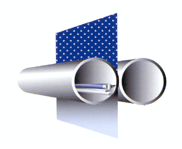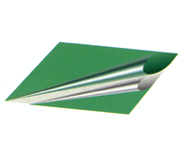|
|
|
| |
|
| |
 |
| |
| |
SuperTex
FABRICS consist of polyester fiber and PVC
(Or other Synthetic resins).
It is produced by a highly advanced method known as a
SOL coating process, in which liquid PVC intensively penetrates
through the polyester fiber into the most minimal areas
thus providing strong adhesive linkages throughout the
entire integrity of the fabrics.
SuperTex Fabrics are also superior to others in dimensional
stability as a result of the pre-heat tempering of its
polyester scrim.
SuperTex Fabrics have excellent effect in flatness on
the surface by repeated coating several times, and in
superiors to others regarding
extra treatment. |
|
| |
- Comparison
by process |
| |
| |
Sol Coating Process(SuperTex Fabrics) |
Calendering
/ Lamination Process |
| General |
Continuous Process.
Plastisol paste is applied to the fabric deeply
by Screen to Screen system.
The applied fabric then passes through a oven causing
the plastisol to change into a molten plastic. The
heat from the oven causes the PVC particles to absorb
the liquid plasticizer completely. When the fabric
cools, the molten plastic hardens to form vinyl-coated
fabrics. |
|
| A vinyl dry blend compound
is extruded to from a molten mass of plastic. This
plastic is fed through a serious of machined heated
rollers called calendering, to form a thin film,
which is then cooled. In a separate operation, layers
of film are applied to a fabric using an adhesive
and pressure to form laminated fabrics. |
|
| Base
Cloth |
| Various base cloths with
variety of weave constructions are available.High
density fiber may be used for greater tensile strength. |
|
| Only low-density base cloth
is available due to adhesionStrength loss.Low tensile
strength. |
|
| Durability |
| With complete liquid PVC
penetration durability is great. |
|
| Adhesion between PVC film
and fiber cause numerous air spaces that leads to
poor durability. |
|
| Dimensional
Stability |
| Less than 1% by Pre-Heat-Control
system. |
|
| 3~10%Rigid film and fiber
are bonded at low temperature. Dimensional stability
is 3~10%. |
|
| Thickness/
Surface |
| Gradual, repetitive, thin-coating
processes creating even thickness and flat surface. |
|
| Lamination of rigid film
and fiber, irregular thickness causes uneven surface. |
|
| illustration |
 |
 |
|
| |
 |
| |
| |
£ªAnti-Mildew, £ªAnti-Static,
£ªAnti(Low)-Wicking , £ªBlackout, £ªCold Crack, £ªFlame Retardant,
£ªFoam, £ªI.R. Protection, £ªLow-e,
£ªNon-Toxic, £ªStripe /Fluorescent Color, £ªWater Based Ink
Receptive Material |
|
| |
 |
| |
| |
£ªAcrylic / Fluoride Gloss (Matt)
Lacquer, £ªMetallic / Silver Coating, £ªPolyurethane, £ªPVDF,
£ªPVF(TedlarR), £ªTPU |
|
| |
|
|
|
